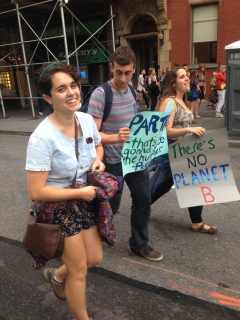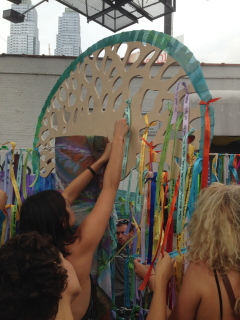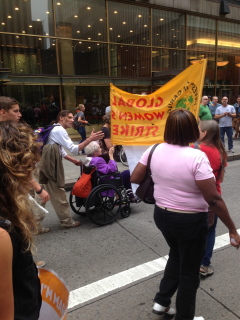“Today, civil society acted at a scale that outdid even our own wildest expectations. Tomorrow, we expect our political leaders to do the same,” –May Boeve, Executive Director of 350.org.
“The People’s Climate March has given tens of thousands of passionate and dedicated allies an opportunity to let the world’s leaders know that we support setting the highest possible goals to address climate pollution, and that the United States must fully embrace and lead a worldwide effort to accelerate the 21st Century’s complete transformation to a prosperous clean energy economy.” –Michael Brune, Executive Director of the Sierra Club
I will begin by honestly stating that I do not feel qualified to give a comprehensive account of the People’s Climate March. I was in a crowd of over 400,000 people, and thus I mostly saw the march through the narrow lens of a student marching near the front. There were so many speeches, demonstrations, floats, and groups that I did not get to see, due to the sheer volume of people. This video covering the events of the day is a good way to see what the crowd looked like and sounded like.
So I will instead give my account of the day, the pictures that I took, and reactions, while providing you with additional articles and thoughts written by people who had more extensive overviews. To give you a feel for how powerful this march was and how many people gave up their Sunday to demand change, some of the notable marchers included U.N. Secretary General Ban Ki Moon, Al Gore, several US senators and representatives, Bill DeBlasio, and several celebrities who have made climate justice a personal mission.
Let’s begin! Last Sunday at 3:00am sharp, I headed off to New York City with three good friends. Many hours later, we found ourselves on the subway, pressed between people clutching signs and wearing coordinated t-shirts with statements like, “Youth Choose Climate Justice” It seemed like everyone in the city was heading to the march. Before it began, there was a moment of silence for those who had been affected by climate change. Soon after, we sounded the “Climate Alarm”, which was a deafening wave of sound that traveled through the crowd. People screamed, used noisemakers and threw their hands in the air.
And then we began to march.

It lasted for several hours, and we held our signs high and chanted the whole way. As we made our way through the city, people leaned out of buildings, watching and cheering us on. Simulcasts placed along the way showed scenes from other sections of the march.
At the end, there was a block-party-type celebration of the action that just occurred. Although our feet were sore, the mood was contagiously jubilant, with a DJ, incredible dancers and drumming. There were art exhibitions as well, including an interactive project called the Climate Ribbon in which attendants were instructed to write about a thing or place that they hoped not to lose to climate change on a ribbon. “The Climate Ribbon is a massive installation and ritual space to grieve what each of us stands to lose to Climate Chaos, and affirm our solidarity as we unite to fight against it.” Hearing participants read each other’s words followed by the affirmation of the crowd proclaiming, “we are with you”, was a powerful experience. It was an intimate space, but the shared experiences and proclamations felt universal. If you are interested in art or its intersection with sustainability, I encourage you to visit their beautifully-designed website to learn more. You can even add your own ribbon online!


Having attended a few marches and protests in the past, I was fascinated by the lack of a leader, or the strong presence of many visible organizers. Some groups handed out signs, and police officers advised us not to block intersections, but other than that, we were free to locate the group that we wanted to march with from the map provided by the website. This was not unintentional. In an article entitled The People’s Climate March and the Wisdom of the Crowd, Hendrik Hertzberg writes about the inherent uniqueness of the march, and how it lived up to the title People’s Climate March. Ultimately, the march represented a collective interest, and the absence of a leader is representative of that. Hertzberg declares, “No speakers? Not quite. More like hundreds of thousands.”
Bill McKibben, well-known activist, founder of 350.org, and the main organizer behind the march, gave his thoughts in a New Yorker article the very next day. In one of my favorite quotes, he writes, “I’ve never thought that people didn’t care. I’ve always thought that, to the contrary, climate change caused a peculiar combination of deep dread and a sense of powerlessness. We are, after all, so small compared to physics. We sense that our individual actions (the light bulbs, the Priuses) won’t add up to enough to matter. In that we’re correct—global warming is fundamentally a structural problem, driven above all by the fact that there’s no price on carbon. This means that the crucial work of individuals is to become, well, less individual, to join together in movements. When those movements seem big enough to potentially make a difference, the powerlessness begins to give way, and we can act on the dread.” Climate change can be an intimidating conversation, but the marchers moved past the urge to ignore it and loudly demanded systematic change. This march is the largest climate action to date, and McKibben’s visible promotion and planning was a key reason that it succeeded.
Finally, I was shocked and impressed by the sheer volume of specific interest groups involved in the march. I knew to expect several subgroups from the march’s website, but seeing the groups with their carefully constructed signs and passionate chants, I fully realized just how many people are invested in this movement. Beyond the groups that I got to observe and photograph, there were groups all over the world marching in solidarity. From Australia to India to Tanzania to Turkey, tens of thousands of people marched and protested on September 21st. It was inspiring. There were marching bands, students, elderly marchers, photographers, and toddlers. I have never been a part of something quite like this before, and I got to talk to a variety of people who share a passion for climate justice and who came from all over the country to attend.
So now that a week or two has passed, the question remains: did the march leave its intended effect? In a way, it remains to be seen. The UN climate summit that just occurred had the intent of laying the groundwork for the Paris summit in 2015, when we may actually see real change. A representative from China, the world’s top carbon emitter, acknowledged the extent to which Chinese people have been affected by weather extremes, and promised future action. Other countries did as well, but more pledges are needed in order to propel the Green Climate Fund. To quote McKibben again, “To borrow a metaphor from the fossil-fuel age, our job is to inject pressure into the system. Marches aren’t subtle; they don’t lay out detailed manifestos (and, in any event, economists have been telling us for a quarter century what we need to do—beginning, again, with putting a price on carbon). Movements work by making the status quo impossibly uncomfortable—by deploying people, arguments, metaphors, and images until our leaders have no choice but to change and, in so doing, release some of that pressure.” The People’s Climate March and events in solidarity sent a message, but it is perhaps only just the beginning of a more united and determined movement to come.
Written by Leslie Wolf, Class of 2015



seem to be a great environment for studying 😛 the students are full of energy 😛